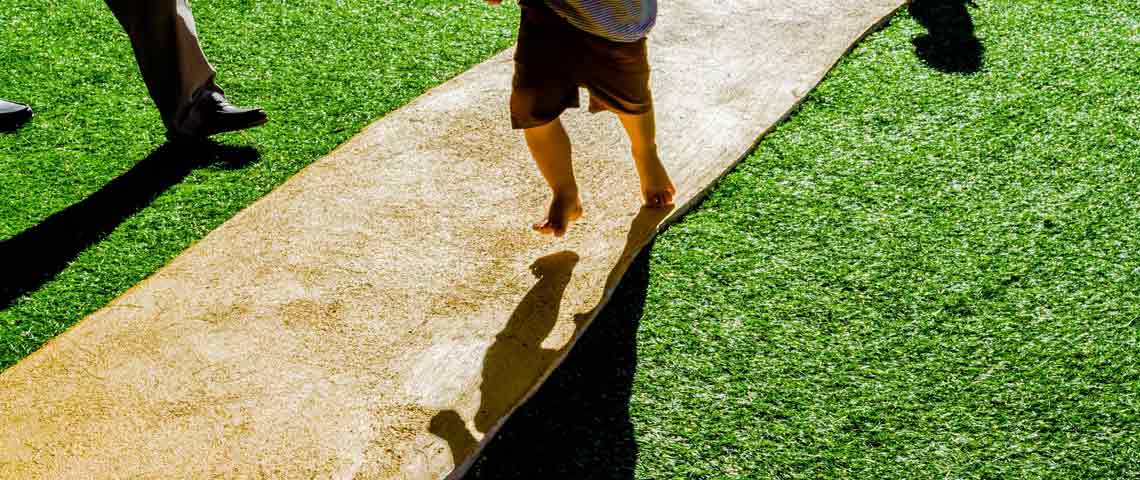Concerns about water usage across the country have some homeowners considering a switch to artificial turf, but the beneficial impact of natural lawns extends far beyond water use. If you’re thinking about making a change from live grass to synthetic alternatives, reconsider the environmental and personal benefits that natural lawns bring to your life.
Natural turf grasses are sustainable, environmentally sound choices that deliver multiple benefits artificial lawns can’t match. The following are a few of the many reasons to keep and value your natural lawn:
1. Natural lawns purify air and improve air quality.
Turf grasses in the United States annually cleanse the air of an estimated 12 million tons of dust and dirt, along with many common impurities such as carbon dioxide.1,2 Once grass blades capture air-borne impurities, dew and precipitation help move them into the root zone, where dust and dirt return to the soil and soil microbes help break pollutants down.1

2. Turf grasses trap and store carbon that might otherwise contribute to global warming.
U.S. lawns capture about 5% of the carbon dioxide from the atmosphere each year.2 Lawn grasses then convert trapped carbon dioxide to a stable form of carbon that’s locked into the soil layer through a process known as carbon sequestration. Rather than being released into the atmosphere and adding to greenhouse gasses, carbon is held in soil where it eventually becomes organic matter.
A healthy, average-size U.S. lawn (about 10,000 square feet) collects and stores up to 300 pounds of carbon per year.4,12 Grass clippings left to decompose on lawns improves their carbon-storing capacity, giving U.S. lawns the potential to store the equivalent of 37 billion pounds of carbon per year.3
3. Natural lawns generate significant amounts of life-supporting oxygen.
A 50-square-foot lawn — just 2,500 square feet — produces enough oxygen to meet the daily oxygen needs of four people.1 That benefit adds up quickly. University of Maryland researchers estimated the state’s 1.15 million acres of managed turf grasses in 2005 generated enough oxygen for 80 million people.4
4. Lawn grasses cool themselves and their surroundings, reducing home cooling needs.
Lawns offset 50% of solar heat through cooling evaporation. On sunny days, surface air temperatures over lawns stay 10° to 14° Fahrenheit cooler than over asphalt or concrete.1 Cooler air temperatures directly impact cooling needs of surrounding homes.
In contrast, surface temperatures of artificial turf can measure 37° Fahrenheit higher than asphalt, and more than 86° Fahrenheit higher than natural grass under the same conditions.5 Eight average natural front lawns have an estimated cooling impact equal to 70 tons of air conditioning.1
5. Natural lawns purify rainwater and improve groundwater quality.
Turf grasses and the soil microbes that exist with them in lawn-like, turf settings reduce environmental contamination by purifying water and breaking down pollutants as they move through the root zone. Pollutants in the atmosphere can make rainfall so acidic it damages the environment. However, filtering rain water through a healthy lawn can reduce its acidity to one-tenth its original, unfiltered state.1 This improves the quality of groundwater and reduces contamination of bodies of water, such as rivers and lakes.

6. Natural turf reduces runoff and helps recharge underground aquifers.
Healthy, established lawns slow the flow of storm water, allowing it to be absorbed into the ground, filtered and returned to aquifers instead of flowing into storm sewers.4 Dense, healthy lawn grasses allow 15 times less runoff than thin, unhealthy lawns,9 and lush turf is six times more effective in absorbing rain than a field of wheat, know for erosion control.1
7. Turf grasses reduce soil erosion caused by water and wind.
Extensive root systems on turf grasses lock soil in place and protect it from loss by wind and water. An estimated 90% of a grass plant’s weight is in its roots, with up to 300 miles of erosion-controlling roots on a single grass plant under optimal conditions.1 Soil-retaining grass shoots of maintained turf ranges from 30 million to more than 8 billion per acre.4 Gardens and other natural, non-grass areas can experience more than 600 times the water erosion of natural lawns.9
8. Natural lawns and lawn clippings increase beneficial soil activity, recondition soil and improve soil quality.
Lawn clippings left to naturally decompose provide nutrients and lead to other benefits. Over the course of a growing season, clippings from a healthy, 1,000-square-foot Kentucky bluegrass lawn equate to about three lawn fertilizer applications. Overtime, natural lawn processes increase activity of beneficial microorganisms in soils, build dark organic matter and improve soil condition and quality.1
9. Well-maintained, natural lawns reduce the risk of fire hazards and help slow the advance of wildfires.
Healthy, well-maintained turf grasses can act as fire retardants and firebreaks, offering significant protection during wildfires. Low-growing natural grass, such as those in maintained lawns, present a low hazard with low potential for fueling fires.8

14. Natural grassy outdoor areas can improve physical and mental well-being.
Lawns and exposure to natural outdoor greenery can reduce stress, lower blood pressure, reduce muscle tension, improve attention and increase feelings of happiness and serenity.4 For children diagnosed with Attention Deficit Disorder (ADD), play in grassy outdoor areas has resulted in significantly better functioning and fewer symptoms than play that occurred without exposure to such spaces.11 Additional benefits are still being discovered.
Natural lawns benefit the environment, your community and your family’s quality of life in ways that synthetic lawns simply can’t. Instead of artificial substitutes, incorporate water-wise lawn care practices and natural alternatives, such as flower beds and water-conserving mulches, to enhance natural lawn areas and add to their benefits. A healthy, well-maintained lawn is a sound environmental choice, and Pennington Seed is committed to helping you grow a lush, healthy, sustainable lawn that helps make your world a better place.
Source / Pennington

